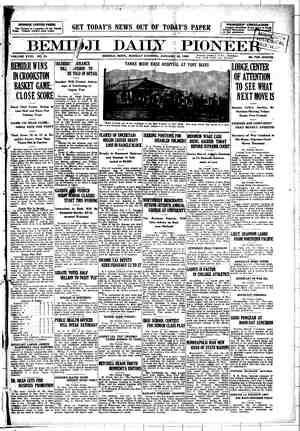The Nonpartisan Leader Newspaper, January 26, 1920, Page 5
You have reached the hourly page view limit. Unlock higher limit to our entire archive!
Subscribers enjoy higher page view limit, downloads, and exclusive features.
T R ed and the shipper credited with each item of value in the dockage. Flax, mustard, oats and feed will be accumulated, and can be marketed in car lots yielding: maximum returns. On the scale the opera- tion will be carried on the work can be done for a small fraction of a cent per bushel. A standard will be set and the farmer will receive full value for his grain. Besides this freight will be saved on the feed which can, with ‘much less cost, HESE pictures, taken on and about the farm home of Governor Lynn J. Frazier of North Dakota, at Hoo- ple, N. D., show the governor in his farm work. The bottom picture is a portrait of the governor's wife; the boy and girls shown in the other pictures are his children. v North Dakota’s governor is a real farmer, not one who lives in town and gets reports from the manager as to how the farm is getting on. He is a farmer of the on-the- soil, shirt-sleeve variety, but he is no country bump- kin. A graduate of the University of North Dakota, he has been prominent in educational work ever since returning from the university to the farm, and as governor he has devoted his best efforts to the building up of the rural schools with the result that North Dakota has more consolidated eountry schools than any other state in the Union. Governor Frazier’s education is not confined to books. His farm at Hoople is one. of the most modern and prosperous in that section, one of the best farming sections of the state. Nor is the man a dull grind, absorbed merely with his farm. While he was at the university Frazier was one of the star football players. It was precisely because he be- lieved that a farmer must be interested in other things than the mere production of food that he joined the Nonpartisan league soon after it had been organized. Later the League chose him as its candidate for governor. After two years of service the voters of North Dakota re-elected him in 1918. Governor Frazier is chairman of the industrial commission of North Dakota, which has charge of the mill and elevator association, the Bank of North Dakota, the home building association and all other industrial enterprises. be back-shipped to the stock feeders in the state. Millions of dollars have been lost to the state by reason of damp grain. This happens every season in parts of the state. Heretofore damp grain has either bin-burned on the farmer’s hands, or been sold at heavy discounts. Only three of the termi- nals in the Twin Cities have dryers, comparatively recently installed. The state terminal will have a dryer and any damp-grain can be dried, saving the A FARMER GOVERNOR—WHY NOT A FARMER PRESIDENT? PAGE FIVE freight on the surplus water, and bringing the grain up to its proper grade and value. Other millions of dollars have been lost by heavy discounts on smutty grain, bin-burned and musty grain. A comparatively inexpensive operation of washing and drying can bring such grain back. Smutty grain may be, in fact, No. 1 grain when washed and dried but sold way down the scale on (Continued on page 13) OVERNOR FRAZIER is not a candidate for pres- ident. Farmers of South Dakota, under the new primary law in opera- 5 tion in that state, nom- inated Governor Frazier as League candidate for president in that state. Politicians put in the names of such men as Lowden, Wood, Poindexter, Gerard, etec. The South Dakota law provides that a person thus nominat- ed, to have his name go upon the presidential primary- ballot, must file a certificate . stating that if nominated and elected he will accept the office. Lowden, Wood, Poindexter and Gerard fulfilled this requirement readily, showing: their eagerness to be elected. Governor Frazier did not. When friends asked him why he answered: “T am not a .candidate for president. My work is here in North Dakota.” But in spite of Governor Frazier’s unwillingness to put himself forward, there is need of a people’s president. . There is need of a man who will be, to the United States, what Lynn J. Frazier has been to North Dakota. If there is no. such man among the eager candidates for the office the peo- ple of the United States should organize and draft such a man for their service, just as the farmers of North Dakota drafted Lynn J. Frazier for gov- ernor. Possibly that can not be done at this elec- tion. Possibly the League should continue to de- vote its energies to the installing of people’s gov- ernments in the 13 states. If the farmers of North Dakota decide that Governor Frazier can not be spared from that state at this time, if the farmers decide that it would be best policy this year for them to devote their attention principally to getting control of the state governments in the interests of the people, then at least by 1924 plans should be laid for drafting a real people’s president. ; P —— i WD W W g ey B e i S ————— e






